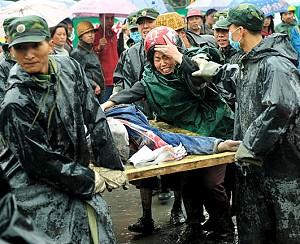
DUJIANGYAN, China–The death toll from China’s most devastating earthquake in three decades has jumped to at least 11,921, a top disaster official said on Tuesday, as storms hampered rescuers in the most devastated areas.
State media reports indicated that the number of dead from the 7.9 magnitude quake was likely to soar.
Xinhua news agency said 10,000 people were buried in the Mianzhu area of southwestern Sichuan province alone. Troops had also arrived for the first time at Wenchuan county, the epicentre of the quake.
“The death toll from this disaster has already reached 11,921,” Wang Zhenyao, disaster relief chief under the Ministry of Civil Affairs, told reporters.
“The first priority is to save people... As long as there is the slightest hope, we will try to save them,” Wang said, adding that the biggest threat to life was now mudslides.
It was not immediately clear whether Wang’s toll was confined to Sichuan province. Hundreds more have perished in neighbouring provinces.
A strong aftershock rocked Chengdu, capital of Sichuan, on Tuesday afternoon, one of more than 1,950 over the past day and keeping nervous residents on edge.
“Office workers in downtown Chengdu took to the streets again after the quake,” Xinhua said, adding it was thought to be the strongest since Monday’s tremor.
An official from China’s seismological bureau official said more strong aftershocks could still hit Sichuan, Xinhua said, as hotels in Chengdu told guests to stay on lower floors.
Heavy storms and wrecked roads hampered efforts to reach areas hardest-hit by China’s worst earthquake in three decades on Tuesday.
Premier Wen Jiabao, visiting Sichuan, ordered troops to clear roads to Wenchuan, a hilly area about 100 km (62 miles) from Chengdu.
Damage from Monday’s quake left the area, about 1,600 km southwest of Beijing, completely cut off.
And rain and thick clouds over a province famous for its giant panda reserves meant that military helicopters sent to the area could not yet land.
State television showed highways buckled and caved in from the quake and massive rockslides lining the roads.
Bodies in Streets
In Dujiangyan–about midway between Chengdu and the epicenter–there was devastation, with buildings reduced to rubble and bodies in the streets.
Troops and ambulances thronged the streets, and military trucks able to do heavy lifting had arrived. But many residents simply stood beside their wrecked homes, cradling possessions in their arms. Others huddled in relief tents under heavy rain.
“At least 60 or 70 old people lived there, as well as children,” said a hospital worker surnamed Huo, gesturing to a building in ruins. Mattresses and household objects could be seen poking through the rubble.
“How could they survive that?” she asked.
Rescuers had worked frantically through the night, pulling bodies from homes, schools, factories and hospitals demolished by the quake, which rolled from Sichuan across much of China and was felt as far away as Bangkok and Hanoi.
In Dujiangyan, about 900 teenagers were buried under a collapsed three-storey school building. Premier Wen bowed three times in grief before some of the first 50 bodies pulled out, Xinhua reported.
“Not one minute can be wasted,” said Wen, a trained geologist. “One minute, one second could mean a child’s life.”
Frantic relatives tried to push past a line of soldiers surrounding the school, desperate for news of their children.
“We’re still pulling out people alive, but many, many have died,” said one medical worker.
At a second school in Dujiangyan, fewer than 100 of 420 students survived, Xinhua reported.
The initial tremor was followed by a series of aftershocks, which shook the area through the night. “Some are still very strong,” said a Dujiangyan resident. “We have put up tents outside to sleep in.”
A group of about 15 British tourists were out of reach near the epicentre, likely in Wolong a panda reserve whose phone lines were cut by the quake, Xinhua reported. China said that there had been no reports of foreign casualties as of midday (0400 GMT).
‘Time Is Life’
China’s benchmark stock index ended down on Tuesday and trading in the shares of 66 companies was suspended.
However, analysts said they did not expect a major economic impact from the disaster, though it could mean supply shortages that fuel inflation, already at a near 12-year high.
China’s largest life insurer, China Life, said it expects claims for the quake to far exceed those for freak snowstorms that hit the country early this year.
China’s Communist Party leadership announced that coping with the quake’s aftermath and ensuring that it did not threaten social stability were the government’s priorities.
But bloggers wondered about the quality of construction and why so many school buildings were reduced to rubble.
Tibet’s spiritual leader the Dalai Lama, accused by Beijing of involvement in deadly riots in the Tibetan capital in March, expressed his concern and offered his condolences to quake victims.
The United Nations said it was ready to support China in its efforts to respond to the disaster, a spokesman for U.N. Secretary General Ban Ki-Moon said.
China on Tuesday welcomed offers of international aid and said it was moved by the show of support.
The Sichuan quake was the worst to hit China since the 1976 Tangshan tremor in northeastern China where up to 300,000 died. Then, unlike now, the Communist Party kept a tight lid on information about the extent of the disaster.
Neighbouring areas of Sichuan were also affected, with 213 reported dead in the northwestern province of Gansu, 92 in Shaanxi province and school collapses in the municipality of Chongqing.




Friends Read Free